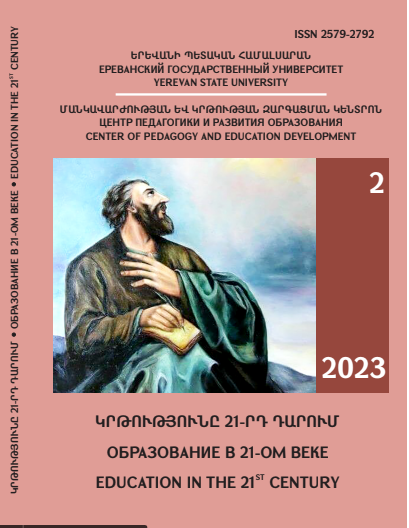TEACHING FEATURES AND METHODOLOGY OF THE SUBJECT "ARMENIAN DIPLOMACY IN THE NEW PERIOD"
DOI:
https://doi.org/10.46991/ai.2023.2.176Keywords:
Armenian diplomacy of the new period, system memory of diplomacy, evolution of orientations of foreign policy, teaching characteristics and methods, educational outcomeAbstract
The teaching of the Armenian diplomacy in general and new times in particular is extremely important for specialized faculties because the state’s current diplomacy and its future vision should be built first of all on the lessons and realities of the past. In this way, world-famous British, French, Russian, Turkish and other diplomatic schools were formed, based on the existence of a continuous and long-term statehood, with a continuous chain of reborn and (or) renewed diplomacy. For an effective observation of the teaching features of the Armenian diplomacy of the new times, it is very important to highlight the features, goals, methods, manifestations of the diplomacy of that period, the process of foreign political orientations, challenges and problems, which are the key guidelines of the teaching methodology. They are the backbone of the course. The most important feature affecting the diplomacy of this period was the absence of statehood throughout that period (from the mid-17th century to 1918). Therefore, the main goal of Armenian diplomacy was the restoration of the Armenian state, and the key issue of Armenian diplomacy was the division of Armenia. In 1639, according to the Qasr-e Shirin Treaty, Western Armenia came under the rule of the Ottoman Empire, and Eastern Armenia came under the rule of Safavid Iran. In 1828, Eastern Armenia passed to Russia, and the division continued. In 1878, the Armenian Question appeared on the platforms of international diplomacy, which was both an opportunity and a challenge. It is important to identify the evolution of Armenian foreign political orientations, the reasons for the changes and the challenges. Despite the predominantly Russian orientation of Armenians, the Armenian political elite has always looked for an effective alternative, which is still very relevant today. Teaching methods should combine both teacher-centered and student-centered approaches. At the end of the course, the student should acquire the following abilities: knowledge, understanding, application, analysis, synthesis (combination), evaluation skills. It is also very important to motivate the student. Two factors can be considered here: an encouraging assessment and the importance of the profession of an internationalist-diplomat.
References
Օգտագործված գրականության ցանկ:
Բայբուրդյան Վ. Օսմանյան կայսրության պատմություն, Երևան, 2011:
Բայբուրդյան Վ. Իրանի պատմություն, Երևան, 2005:
Բուդաղյան Ա., Գրիգորյան Ա., Արդյունահեն դասընթացների և կրթական ծրագրերի մշակում: Դասախոսի ձեռնարկ, Երևան 2017:
Լեո, Հայոց պատմություն, հատոր 3-րդ, գիրք 2-րդ, Երևան, 1973:
Հայաստանը միջազգային դիվանագիտության և Սովետական արտաքին քաղաքականության փաստաթղթերում (1828-1923), Ջ. Կիրակոսյանի խմբագրությամբ, Երևան, 1972:
Հայոց պատմություն, Հ. Սիմոնյանի խմբագրությամբ, Երևան 2012:
Հասան Ջալալյան Ե., Պատմություն համառոտ Աղուանից երկրի, Ստեփանակերտ, 2007:
Մանուչարյան Հ., Դրվագներ հայ քաղաքական մտքի պատմության, Երևան, 2002:
Պողոսյան Ս., Հայաստանի ինքնավարության ծրագրերը. 1878թ., Երևան, 2018:
Սեբաստացի Ղ. Դավիթ Բեկ կամ պատմություն ղափանցոց, Երևան, 1992:
Downloads
Published
How to Cite
Issue
Section
License
Copyright (c) 2023 Shirak Torosyan

This work is licensed under a Creative Commons Attribution-NonCommercial 4.0 International License.

